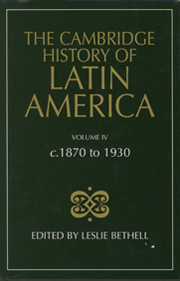Book contents
- Frontmatter
- 1 Latin America and the international economy, 1870–1914
- 2 Latin America and the international economy from the First World War to the World Depression
- 3 Latin America, The United States and the European powers, 1830–1930
- 4 The population of Latin America, 1850–1930
- 5 Rural Spanish America, 1870–1930
- 6 Plantation economies and societies in the Spanish Caribbean, 1860–1930
- 7 The growth of Latin American cities, 1870–1930
- 8 Industry in Latin America before 1930
- 9 The urban working class and early Latin American labour movements, 1880–1930
- 10 Political and social ideas in Latin America, 1870–1930
- 11 The literature, music and art of Latin America, 1870–1930
- 12 The Catholic Church in Latin America, 1830–1930
- Bibliographical essays
- Index
- References
7 - The growth of Latin American cities, 1870–1930
Published online by Cambridge University Press: 28 March 2008
- Frontmatter
- 1 Latin America and the international economy, 1870–1914
- 2 Latin America and the international economy from the First World War to the World Depression
- 3 Latin America, The United States and the European powers, 1830–1930
- 4 The population of Latin America, 1850–1930
- 5 Rural Spanish America, 1870–1930
- 6 Plantation economies and societies in the Spanish Caribbean, 1860–1930
- 7 The growth of Latin American cities, 1870–1930
- 8 Industry in Latin America before 1930
- 9 The urban working class and early Latin American labour movements, 1880–1930
- 10 Political and social ideas in Latin America, 1870–1930
- 11 The literature, music and art of Latin America, 1870–1930
- 12 The Catholic Church in Latin America, 1830–1930
- Bibliographical essays
- Index
- References
Summary
Introduction
The European or North American who visited Latin America in the years before 1870 invariably came away struck by the diversity of the area – in geography, in people, in environment. Cities there were. Indeed cities had played a dominant role in the development of Spanish America at least, even when they contained only a small percentage of the area's total population. But generally they appeared small, poor and broken down. Far more impressive was the countryside of Latin America – the imposing Andean mountains, the vast Amazonian jungle, the endless grasslands of the llanos or the pampas, the picturesque Indian hamlets, the enormous landed estates. Consequently it was rural Latin America that most vividly emerged from the travel accounts, letters and dispatches of the middle decades of the nineteenth century. Nevertheless, a bird's eye view of the Latin American city in 1870 will set the stage for the dramatic changes that the ensuing decades brought to the area's urban landscape.
Even the largest Latin American cities appeared small, in large measure because of their plaza-orientation. Both the residences of the wealthy and the powerful and the principal urban activities of administration, services and trade were concentrated around the central plaza. Rio de Janeiro, Havana, Mexico City and Buenos Aires all had central districts of only a few hundred blocks. These areas, often extending no more than five or ten blocks from the main plaza, had the appearance of an urbanized zone: substantial housing, paving, sidewalks and street lights. Located in this central district were markets, offices, stores, clubs, theatres, churches and schools to serve the elite.
- Type
- Chapter
- Information
- The Cambridge History of Latin America , pp. 233 - 266Publisher: Cambridge University PressPrint publication year: 1986
References
- 3
- Cited by

